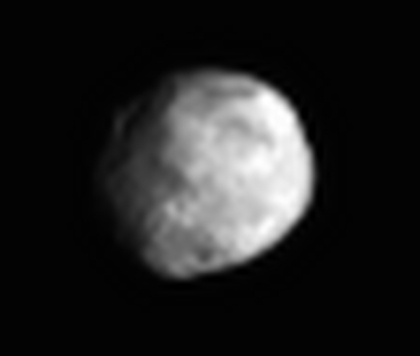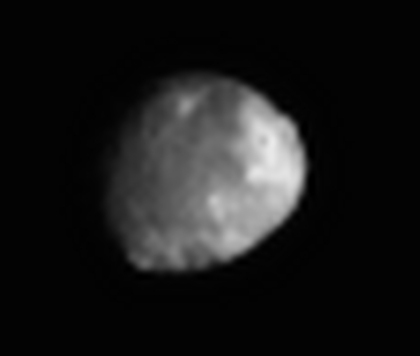
|
Press Release 15/2011
|
 |

|
Press Release 15/2011
|
 |
Press Release 15/2011 - June 23, 2011
Although about 189,000 kilometers still lay between NASA's space probe Dawn and the asteroid Vesta, the latest images taken by the camera system on board show a heterogeneous surface structure.
"Even though in this early approach phase the camera system mainly serves navigational purposes, the images are beginning to show us a new, unique world", says Dr. Andreas Nathues from the Max-Planck-Institute for Solar System Research (MPS) in Germany, Framing Camera Lead Investigator. The newest images now reveal first surface structures. "In many surface regions we see patterns that might well be craters", says Dr. Holger Sierks from MPS, one of the mission's co-investigators and responsible for the development of the camera. In the next weeks as Dawn continues its approach of the asteroid, the scientists will be able to confirm this first analysis.

|

|
|
Figure 1: These images of asteroid Vesta were obtained on June 20th, 2011, from a distance of about 189 000 kilometers. |
|
(Credits: NASA/JPL-Caltech/UCLA/MPS/DLR/IDA) |
NASA's space probe Dawn has been on its way to the asteroid Vesta since 2007. Vesta's gravity is expected to capture the spacecraft on July 16th, 2011. The space probe will then accompany the asteroid for approximately a year. Dawn's stay at Vesta is the first prolonged visit to a main belt asteroid. It will also be the first visit ever to a protoplanet, a body that never quite became a full-fledged planet. Scientists expect Vesta to render information on the early phase of planet formation.
The Dawn mission to Vesta and Ceres is managed by NASA's Jet Propulsion Laboratory, a division of the California Institute of Technology in Pasadena, for NASA's Science Mission Directorate, Washington. The University of California, Los Angeles, is responsible for overall Dawn mission science. The Dawn framing cameras have been developed and built under the leadership of the Max Planck Institute for Solar System Research, Katlenburg-Lindau, Germany, with significant contributions by DLR German Aerospace Center, Institute of Planetary Research, Berlin, and in coordination with the Institute of Computer and Communication Network Engineering, Braunschweig. The Framing Camera project is funded by the Max Planck Society, DLR, and NASA/JPL.
![]() "Rotation Movie from June 20"
(Movie in "m4v" format, 427KB)
"Rotation Movie from June 20"
(Movie in "m4v" format, 427KB)
Dr. Birgit Krummheuer
Press and Public Relations
Max Planck Institute for Solar System Research
Max-Planck-Straße 2
37191 Katlenburg-Lindau
Tel.: 05556 979 462
Fax: 05556 979 240
Mobil: 0173 3958625
Email: krummheuer![]() mps.mpg.de
mps.mpg.de
Dr. Andreas Nathues
Framing Camera Lead Investigator
Max Planck Institute for Solar System Research
Max-Planck-Straße 2
37191 Katlenburg-Lindau
Tel.: 05556 979 433
Fax: 05556 979 240
Email: nathues![]() mps.mpg.de
mps.mpg.de
| © 2009, Max Planck Institute for Solar System Research, Lindau |
Presseinfo 23-06-2011 |